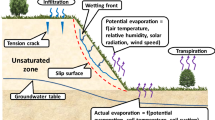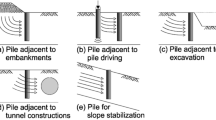Abstract
A coupled elastic–plastic finite element analysis based on simplified consolidation theory for unsaturated soils is used to investigate the coupling processes of water infiltration and deformation. By introducing a reduced suction and an elastic–plastic constitutive equation for the soil skeleton, the simplified consolidation theory for unsaturated soils is incorporated into an in-house finite element code. Using the proposed numerical method, the generation of pore water pressure and development of deformation can be simulated under evaporation or rainfall infiltration conditions. Through a parametric study and comparison with the test results, the proposed method is found to describe well the characteristics during water evaporation/infiltration into unsaturated soils. Finally, an unsaturated soil slope with water infiltration is analyzed in detail to investigate the development of the displacement and generation of pore water pressure.







Similar content being viewed by others
References
Alonso EE, Gens A, Delahaye CH (2003) Influence of rainfall on the deformation and stability of a slope in overconsolidated clays: a case study. Hydrogeol J 11:174–192
Basha HA (1999) Multidimensional linearized non-steady infiltration with prescribed boundary conditions at the soil surface. Water Resour Res 35(1):75–83
Basha HA (2000) Multidimensional linearized non-steady infiltration toward a shallow water table. Water Resour Res 36(9):2567–2573
Bathurst RJ, Ho AF, Siemens G (2007) A column apparatus for investigation of 1-D unsaturated-saturated response of sand–geotextile system. Geotech Test J 30(6):1–9
Bishop AW (1955) The principal of effective stress. Teknsik Ukebl 106:859–863
Borja RI, Liu X, White JA (2012) Multiphysics hillslope processes triggering landslides. Acta Geotech 7:261–269
Borja RI, White JA, Liu X, Wu W (2012) Factor of safety in a partially saturated slope inferred from hydro-mechanical continuum modeling. Int J Numer Anal Meth Geomech 36(2):236–248
Borja RI, Song X, Wu W (2013) Cam-clay plasticity, Part VII: triggering a shear band in variably saturated porous media. Comput Methods Appl Mech Eng 261–262:66–82
Brooks RH, Corey AT (1964) Hydraulic properties of porous medium. Hydrology Paper No.3, Civil Engineering Department, Colorado State University, Fort Collins, Co
Cai F, Ugai K (2004) Numerical analysis of rainfall effects on slope stability. Int J Geomech 4(2):69–78
Chen JM, Tan YC, Chen CH (2001) Multidimensional infiltration with arbitrary surface fluxes. J Irrig Drain Eng 127(6):370–377
Cho SE, Lee SR (2001) Instability of unsaturated soil slopes due to infiltration. Comput Geotech 28:185–208
Conte E (2004) Consolidation analysis for unsaturated soils. Can Geotech J 41:599–612
Deng G, Shen ZJ (2006) Numerical simulation of crack formation process in clays during drying and wetting. Geomech Geoeng Int J 1(1):27–41
Ehlers W, Graf T, Ammann M (2004) Deformation and localization analysis of partially saturated soil. Comput Methods Appl Mech Eng 193:2885–2910
Fredlund DG (2006) Unsaturated soil mechanics in engineering practice. J Geotech Geoenviron Eng 132(3):286–321
Garcia E, Oka F, Kimoto S (2011) Numerical analysis of a one-dimensional infiltration problem in unsaturated soil by a seepage-deformation coupled method. Int J Numer Anal Meth Geomech 35(5):544–568
Griffiths DV, Lu N (2005) Unsaturated slope stability analysis with steady infiltration or evaporation using elasto-plastic finite elements. Int J Numer Anal Meth Geomech 29:249–267
Hilf JW (1948) Estimating construction pore pressures in rolled earth dams. In: Proceedings of 2nd international conference on soil mechanics and foundation engineering, Rotterdam, The Netherlands, vol 3, pp 234–240
Khalili N, Valliappan S, Wan CF (1999) Consolidation of fissured clays. Geotechnique 49:75–89
Lewis RW, Schrefler BA (1987) The finite element method in the deformation and consolidation of porous media. Wiley, New York
Le TMH, Gallipoli D, Sánchez M, Wheeler SJ (2012) Stochastic analysis of unsaturated seepage through randomly heterogeneous earth embankments. Int J Numer Anal Method Geomech 36:1056–1076
Liakopoulos A (1964). Transient flow through unsaturated porous media. Ph.D. thesis, University of California at Berkeley
Liu EL, Xing HL (2009) A double hardening thermo-mechanical constitutive model for overconsolidated clays. Acta Geotech 4:1–6
Morel-Seytoux HJ (1978) Derivation of equations for variable rainfall infiltration. Water Resour Res 14(4):561–568
Morel-Seytoux HJ (1981) Analytical results for prediction of variable rainfall infiltration. J Hydrol 59:209–230
Nezhad MM, Javadi AA, Al-Tabbaa A, Abbasi F (2013) Numerical study of soil heterogeneity effects on contaminant transport in unsaturated soil (model development and validation). Int J Numer Anal Method Geomech 37:278–298
Rahardjo H, Lee TT, Leong EC, Rezaur RB (2005) Response of a residual soil slope to rainfall. Can Geotech Eng 42:340–351
Qin A, Sun D, Tan Y (2010) Analytical solution to one-dimensional consolidation in unsaturated soils under loading varying exponentially with time. Comput Geotech 37:233–238
Serrano SE (1990) Modeling infiltration in hysteretic soils. Adv Water Resour 13(1):12–23
Shen ZJ (2003) Simplified consolidation theory for unsaturated soils and its application. Hydro-Sci Eng 4:1–6 (in Chinese with English abstract)
Song X, Borja RI (2014) Mathematical framework for unsaturated flow in the finite deformation range. Int J Numer Methods Eng 97:658–682
Stauffer F, Dracos T (1986) Experimental and numerical study of water and solute infiltration in layered porous media. J Hydrol Eng 84:9–34
Sun W, Sun D (2012) Coupled modelling of hydro-mechanical behavior of unsaturated compacted expansive soils. Int J Numer Anal Method Geomech 36:1002–1022
Wu LZ, Zhang LM (2009) Analytical solution to 1D coupled water infiltration and deformation in unsaturated soils. Int J Numer Anal Meth Geomech 33:773–790
Yang H, Rahardjo H, Wibawa B, Leong EC (2004) A soil column apparatus for laboratory infiltration study. Geotech Test J 27(4):1–9
Yang H, Rahardjo H, Leong EC (2006) Behavior of unsaturated layered soil columns during infiltration. J Hydrol Eng 11(4):329–337
Zhan LT, Ng CWW (2004) Analytical analysis of rainfall infiltration mechanism in unsaturated soils. Int J Geomech 4:273–284
Acknowledgments
The authors thank Professor Ronaldo I. Borja of Stanford University and the anonymous reviewers for their careful review, contributions and critics, which led to the improvement of the article. This work was funded by International Science & Technology Cooperation Program of China (Grant No. 2012DFA60760) and the Fundamental Research Funds for the Central Universities (Granted No. 2013G1502009).
Author information
Authors and Affiliations
Corresponding author
Appendices
Appendix 1
From the simplified phase diagrams (see Fig. 8) for an unsaturated soil, we have
so we obtain V a = V v − V w. However, for the unsaturated soils, some air is embedded in the water, which can be formulated by the simplified method as V a′ = c h V w, so the total air content of a unit volume of unsaturated soil element can be obtained:
We define n a = [1 − S r + c h S r]n = [1 − (1 − c h)S r]n, where n is the ratio of the pore air of a unit soil element, which signifies the air content in the voids of a soil element within unit volume.
Appendix 2
For a unit volume soil element, the pore air pressure u a will be generated upon loading. Under the conditions that the air in the voids cannot be discharged, from Boyle’s law, we have
in which p a is the atmospheric pressure, u a is the pore air pressure, V a0 is the initial content of pore air of a unit volume soil element (the corresponding pore air pressure u a0 = 0), and V a is the content of pore air of a unit volume soil element. For a unit volume soil element (see Fig. 8), we have V w = nS r and V a = n(1 − S r). Combining equation (4), n a = [1 − (1 − c h)S r]n, and Eq. (34), we have
in which n a0 is the initial ratio of pore air of a unit soil element, n a0 = [1 − (1 − c h)S r0]n 0, S r0 is initial degree of saturation, and n 0 is initial porosity.
Because the initial air pressure is equal to the atmospheric pressure (u a0 = 0), from Eq. (35), we have:
Appendix 3
In the following, we ignore the flow of the dissolved air in the pore water, the vapor in the pore air, and the influence of temperature. For a unit volume soil element, the mass of pore air discharged per unit time has the following equation (mass conservation equation):
in which q a is the mass of pore air discharged within a unit soil element. From Eq. (34), we can deduce the following equation in incremental form:
Differentiating equation (5), ρ a = ρ a0(1 + u a/p a), we have
From Eq. (7), we have
Substituting Eqs. (39) and (40) into Eq. (38), we obtain
Substituting Eq. (5), ρ a = ρ a0(1 + u a/p a), into Eq. (41), we have
Appendix 4
The Eq. (8) can be expressed as:
Integrating the above equation, we obtain the following:
Substituting the initial conditions n a0 and u a0 into Eq. (44), we have
Combining Eqs. (44) and (45), we have
Appendix 5
The elements of the coefficient matrix in the finite element Eq. (33) are as follows:
where c s = μn/S r
Rights and permissions
About this article
Cite this article
Liu, E., Yu, HS., Deng, G. et al. Numerical analysis of seepage–deformation in unsaturated soils. Acta Geotech. 9, 1045–1058 (2014). https://doi.org/10.1007/s11440-014-0343-y
Received:
Accepted:
Published:
Issue Date:
DOI: https://doi.org/10.1007/s11440-014-0343-y





